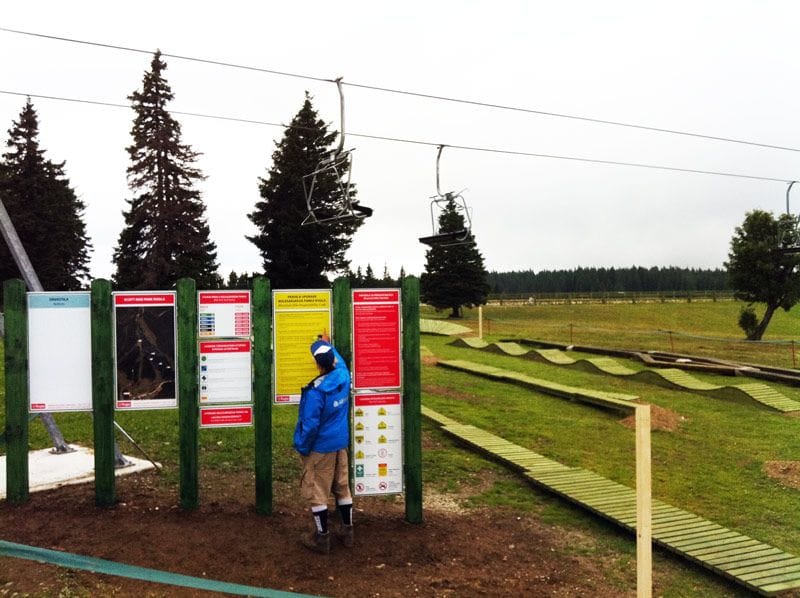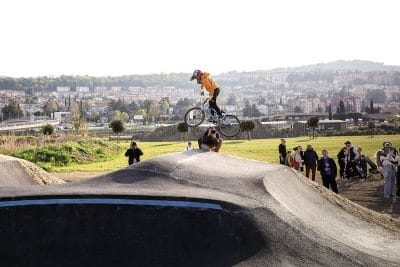
Bike Park Rules and Guidelines
It took a while for the ski resorts to implement basic rules and guidelines for behaviour of skiers on the slopes. At first these rules varied from resort to resort, however in the end at least in Europe the 10 FIS rules were implemented to standardize them and make them more understandable for slope users.
As we like to compare development of bike parks to the development of ski resorts and as we can see the development of bike parks is taking a familiar path to the development of ski slopes, we can witness similarities in the area of park rules and signage. The bike park rules and guidelines are at the beginning of the above described journey that ski resorts have already made for skiing. Even though the path is known and there is also the proper knowledge, there are no standardized rules and guidelines for bike parks.
Current situation is not good for anyone. The resorts develop their own rules based on their knowledge and experiences, however these rules can sometimes be inadequate to properly inform visitors or protect the resort in case of a law suit.
As it does not seem that the UCI will develop standardized rules soon, the resorts can only rely on the best practices from other resorts, use their own knowledge and consult with lawyers. Apart from that it would be useful for the bike parks to cooperate at least on the national level and develop standardized rules. Furthermore, bike parks, included in the consortium initiative like for example Gravity Card can develop a standardized list of rules inside the consortium.
So what should the bike park rules and guidelines be, and how do they look like? These rules should be short and meaningful and inform the visitor of the bike park (and also other potential resort visitors) about obligatory and recommended behaviour to ensure the maximum possible safety level for all involved. We have studied bike park rules and guidelines from dozens of bike parks from all over the world and made selection of 10 rules/recommendations for desired behaviour in the bike park, following the model of 10 FIS rules:
- Riding in the park is only permitted if you wear helmet and protective equipment is strongly recommended.
- The first ride should be intended for getting to know the tracks and their obstacles.
- Do not stop at a point where you are not visible for other persons or where you bar the way. The rider who enters, picks a trail or makes a stop, has to ensure that no dangerous situation occurs.
- Ride on designated and marked trails only Do not cut switchbacks.
- Ride on the trails, that are suitable for your skill level.
- If you encounter a stretch of trail that is beyond your ability, walk your bike until you reach a section you’re comfortable riding.
- Keep off all closed trails and closed areas. Observe and obey all signs and warnings.
- If you get involved in a collision or you become witness of a collision or an accident you have to remain at the scene of the accident and inform the bike patrol. Witnesses and involved persons are obliged to state personal data.
- Do not use the lifts or terrain if your ability is impaired through the use of drugs or alcohol. Bikes only.
- No hiking or motorized vehicles.
- Furthermore, such a sign must include an emergency telephone number and it is also advised to include liability claim, explanation of skill levels and signs that can be found in the park.
Apart from the content of bike park rules and guidelines it is also important where and how they are presented to the visitors. Usually these rules are positioned on a sign close to the entrance to the bike park, at the counter where tickets are sold, or together with a trail map. However these rules and guidelines can be in most cases overseen because they do not stand out from a large number of other signs and commercial banners which usually surround then. Furthermore, visitors at that spots usually do not pay that much attention and time to study these rules.
Getting the visitor the opportunity to read the rules and guidelines while he or she has not much to do, as for example on the way up in gondola or chair lift is probably a better approach. Apart from that they can also be a part of the trail map, visible on the website and on bike park smartphone applications.


